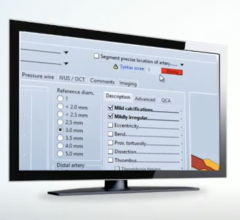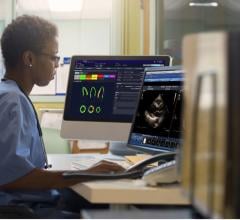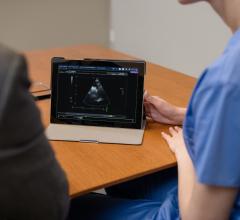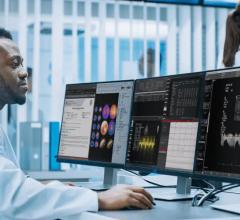
The Discovery IGS 730 system was designed to address the challenge departments historically have had in needing to switch between ceiling-, floor-mounted and mobile C-arm systems. It uses a wireless, laser-guided, motorized mobile gantry, allowing it to be moved anywhere in a room. It is ideal for hybrid ORs because it can be parked away from the patient table, allowing better table access for open surgery.
The American College of Cardiology (ACC) 2012 Scientific Session, held March 24-27 in Chicago, was the first major cardiology show this year for vendors to display their latest innovations. A couple of key trends were evident on the show floor – new technology to support trans-aortic valve replacement (TAVR) and the launch of new cardiovascular image and information systems (CVIS) to support healthcare’s adoption of proposed Stage 2 meaningful use requirements.
Software for Screening, Planning and Performing TAVR
With the approval of the Edwards Sapien valve in November 2011, several vendors have created TAVR software to help screen patients, plan procedures and guide the procedures in the cath lab or hybrid operating room (OR). GE Healthcare’s ValveAssist and Siemens’ syngo Aortic ValveGuide software were demonstrated at ACC. The software uses computed tomography (CT) or magnetic resonance imaging (MRI) datasets reconstructed for the anatomy of interest. The images are analyzed to obtain precise measurements, including the exact location of the coronary ostia, the lowest points of the aortic root and annulus sizing. The software also aids in the pre-procedural assessment of the femoral access route. If the anatomy cannot accommodate large introducers or the device, transapical access can be considered.
Both vendors’ software allows for the use of rotational angiography, which creates CT-like, 3-D reconstructions of the aorta and aortic root while the patient is on the table in the cath lab or hybrid OR. This enables real-time, final assessment of the anatomy during the procedure and use of that image as an overlay on angiography to help guide the procedure.
During the procedure, both systems display a circle in line with and just below the aortic root to enable a perfect cross-sectional view of the valve for accurate device alignment during deployment. When the view is in plane, the circle appears as a straight line.
Another feature of the syngo Aortic ValveGuide software is that it shows an icon of a C-arm and, as images are rotated at various angles, the icon changes colors to indicate whether that view of the anatomy is possible under angiography. If it is, the system allows these positions to be bookmarked so the C-arm can automatically move into the position for that view.
GE’s system can be synchronized with electrocardiogram (ECG) gating to help compensate for patient heart and respiratory motion throughout the procedure for easier procedure visualization.
Collapsing Introducer for Large TAVR, EVAR Devices
Terumo purchased Onset Medical Corp. in January and displayed Onset’s Solopath introducer sheath for the first time at ACC. The innovative expandable sheath is folded for a low profile, entering the femoral artery with a 5.5 French tip and a collapsed shaft size of 11 French. The device contains a balloon, which is inflated to expand it to its full size with a 20.5 French outer diameter and 18 French inner diameter. This allows for less vessel trauma when there is a need to introduce large devices, such as percutaneous valves or endovascular aortic repair (EVAR) stent grafts.
The shaft can be collapsed back into its folded state to allow easier extraction from the artery, reducing the risk of vessel damage.
Plugging Transapical TAVR Holes
The transapical access route is used in TAVR procedures in patients with anatomy that does not allow for femoral access. The procedure requires a skilled surgeon to sew purse-string sutures around the apex to cinch the myocardium tightly around the TAVR introducer sheath during the procedure. After the procedure, the sutures are used to achieve immediate access closure once the sheath is withdrawn. The technique requires very precise suture placement and can result in complications, such as reduced left ventricular function.
However, a new technology discussed in an ACC session about new TAVR technology may eliminate the need for these sutures and simplify the procedure. Apica Cardiovascular has licensed technology developed by Georgia Tech/Emory University for a transapical device that enables easy access and closure. It has corkscrew-like arms that are twisted into the myocardium to anchor the device. The base of the device then acts as a permanently placed introducer port, through which wires and sheaths can be placed without the need for sutures. The device can be left attached to the heart and used to gain access again if future procedures are required.
Trend in New CVIS Platforms
With hospitals turning their attention to the proposed Stage 2 meaningful use requirements under federal healthcare reform, focus is being given to the informatics systems for each specialty, including cardiology. The Stage 2 proposal would require the CVIS, or cardiology picture archiving and communication system (PACS), to interface with electronic medical records (EMRs). To accomplish this, several vendors at ACC unveiled completely re-engineered versions of their CVIS platforms. They included GE Healthcare, Agfa and Philips. Siemens, McKesson and Infinitt also released several enhancements and new modules for their systems at ACC. With the advent of Stage 2, there is an expectation that many hospitals will upgrade or replace their existing cardiovascular PACS.
In the past, some of the large vendors have been criticized by end-users for use of proprietary software that does not interface easily with other vendors’ devices or software. However, vendors at ACC said their new platforms will allow easier integration with the use of standard programming, based on unmodified HL7 and DICOM standards. They said the new platforms also offer better compatibility with legacy systems and systems from other vendors.
While all the systems presented at ACC offer workflow improvements, Philips Healthcare’s new CVIS presents the most unique patient file presentation. It displays all the patient’s current, prior and upcoming scheduled appointments as icons on a time-line strip across the screen, showing the dates of each patient contact. Taking a lesson from the success of the iPhone/iPad format, Philips uses small picture icons for each type of exam that users can readily identify. Examples include a waveform for an ECG or a coronary tree image for angiography. Users can click on the icon to open the exam. The Philips system was shown as a work-in-progress with release slated for this summer.
GE Healthcare’s new Centricity Cardio Enterprise platform also makes use of similar icons in its lists of patient prior exams.
Instead of the siloed systems of the past, where each subspecialty, clinic and department had its own reporting and scheduling systems, the new breed of CVIS promises total integration. Vendors say their systems offer smooth workflow with scheduling, diagnostic testing, imaging, waveforms, procedural reporting, labs, hemodynamics, inventory, billing and the enterprise-wide EMR systems. The new CVIS systems generally offer single user logins, are Web-based so data can be accessed anywhere and on any computer with an Internet connection, and offer smoother, faster workflows based on user feedback from previous-generation systems. They also tend to offer modules for subspecialties, which can be purchased as needed. The modules can be updated as new software becomes available, without upgrading the entire CVIS.
New Class of Angiography System
GE Healthcare launched two recently U.S. Food and Drug Administration (FDA)-cleared angiography systems offering the high image quality and features of a fixed system, but with the versatility of a mobile C-arm. The Discovery IGS 730 system was designed to address the challenge departments historically have had in needing to switch between ceiling-, floor-mounted and mobile C-arm systems. It uses a wireless, laser-guided, motorized mobile gantry, allowing it to be moved anywhere in a room. It is ideal for hybrid ORs because it can be parked away from the patient table, allowing better table access for open surgery.
The system offers a wide bore design for larger patients, allowing for steep angles and easier rotational angiography 3-D.
GE also introduced the Innova IGS 520/530 with an OR option. It uses a specifically designed table and accessories to enable both transcatheter and open surgical procedures.
Advances in Cardiac Ultrasound
Siemens recently released version 2.0 of its Acuson SC2000 cardiac ultrasound system. While offering improved workflow and several new applications, an innovation that could have a big impact on interventional structural heart and electrophysiology (EP) procedures is the system’s introduction of volumetric intra-cardiac echocardiography (ICE). It integrates with the new Acuson AcuNav V ultrasound catheters currently pending regulatory review.
Siemens demonstrated the catheter’s ability to obtain 3-D cine volumes, which can be rotated to better visualize the anatomy inside the heart. The image offers an accurate model of the interior of the heart, which may offer an alternative to visualizing ablation procedures, instead of relying on a computer model created by an EP electro-mapping system. Siemens said it is developing an EP ablation scar mapping system that will overlay on its 3-D ICE images.





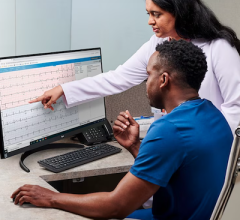
 November 06, 2025
November 06, 2025 


